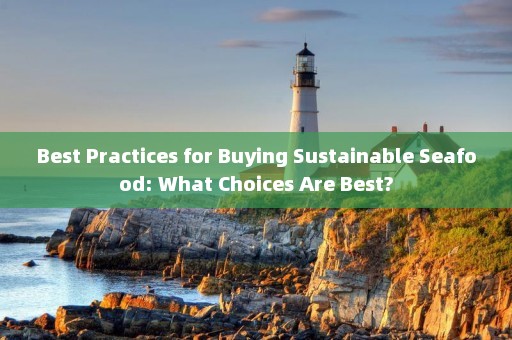Imagine this: You're at the local fish market, gazing at the stunning array of seafood before you. The scent of the ocean fills the air, and your mouth waters at the thought of a fresh, delicious meal. But as you reach for that perfect fillet, a thought crosses your mind – is this seafood sustainable? Join me as I share my journey of discovering the best practices for buying sustainable seafood, and learn how you can make informed choices that benefit both your taste buds and the environment.

Understanding the Importance of Sustainable Seafood
As a passionate cook and environmental advocate, I've always been aware of the impact our food choices have on the planet. When it comes to seafood, the stakes are particularly high. Overfishing, destructive fishing methods, and habitat destruction have led to the depletion of many fish stocks and the endangerment of marine ecosystems. By choosing sustainable seafood, we can help reverse this trend and protect our oceans for future generations.
How to Identify Sustainable Seafood
1. Look for Certification Labels
One of the easiest ways to identify sustainable seafood is by looking for certification labels from reputable organizations such as the Marine Stewardship Council (MSC) or the Aquaculture Stewardship Council (ASC). These labels indicate that the seafood has been sourced from well-managed fisheries or farms that minimize their environmental impact.
2. Know Your Fish
Researching different types of fish and their sustainability status can help you make informed choices. Some fish, like salmon, have specific sustainability guidelines depending on the region and fishing method. For example, wild-caught Alaskan salmon is generally considered sustainable, while farmed salmon may have varying environmental impacts.
3. Consider the Fishing Method
The method used to catch seafood is crucial in determining its sustainability. Opt for seafood caught using pole-and-line, trap, or troll fishing methods, as these are typically more selective and cause less harm to the marine environment. Avoid seafood caught using bottom trawling or dredging, as these practices can damage ocean floors and result in bycatch (unwanted fish and marine life).
My Personal Experience and Insights
During my journey to buy sustainable seafood, I've encountered both challenges and successes. One memorable experience took place at a local grocery store. I was looking to purchase shrimp, a family favorite, but quickly realized that not all shrimp are created equal. After researching and consulting with a knowledgeable seafood clerk, I discovered that Gulf shrimp caught using turtle excluder devices (TEDs) were a sustainable choice. These devices allow sea turtles to escape from shrimp nets, reducing bycatch and protecting these endangered species.
Another insight I've gained is the importance of seasonality. Certain fish, like striped bass, have specific spawning seasons. By avoiding these periods, we can help protect fish populations and ensure their sustainability. I've learned to plan my meals around seasonal seafood, not only supporting the environment but also enjoying the freshest flavors.
Practical Instructions for Buying Sustainable Seafood
1. Educate Yourself
Stay informed about sustainable seafood options by visiting websites like the Monterey Bay Aquarium's Seafood Watch program. Download their consumer guides or use their mobile app to access up-to-date information while shopping.
2. Support Sustainable Retailers and Restaurants
Shop from retailers and restaurants that prioritize sustainable seafood. These businesses often work closely with suppliers and fisheries to ensure the products they offer meet high environmental standards.
3. Ask Questions
Don't be afraid to ask questions about the seafood you're purchasing. Ask where it's from, how it was caught, and if it has any sustainability certifications. By showing interest and demanding transparency, you're encouraging the industry to prioritize sustainability.
Necessary Precautions to Take
1. Avoid Endangered Species
Steer clear of seafood from endangered species, such as bluefin tuna or shark. These species are at risk of extinction, and consuming them only exacerbates the problem.
2. Be Wary of "Organic" Labels
While organic certifications are valuable for land-based agriculture, they don't always guarantee sustainability in seafood. Look beyond the organic label and consider other factors like fishing method and certification from reputable organizations.
3. Stay Informed About Regulations
Fishing regulations and sustainability guidelines can change over time. Stay informed about these changes to ensure your choices align with current best practices.
Conclusion
Choosing sustainable seafood is a powerful way to protect our oceans and support responsible fishing practices. By following these best practices, you can make informed decisions that benefit both your taste buds and the environment. Remember, every choice counts, and together, we can make a positive impact on our planet's marine ecosystems.
Now, the next time you find yourself at the fish market, you'll be equipped with the knowledge to make the best sustainable seafood choices. Happy cooking and bon appétit!
Post a comment

Comment List